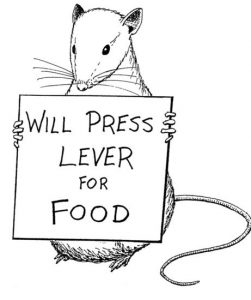Operant Conditioning: What Is It? How Does It Work For Dog Training?
Operant conditioning is, “a type of learning in which the strength of a behavior is modified by its consequences, such as reward or punishment, and the behavior is controlled by antecedents called discriminative stimuli which come to signal those consequences.”
To break down operant conditioning, there is what’s called the operant conditioning quadrant. This quadrant is made up of: Positive Reinforcement, Negative Reinforcement, Positive Punishment, and Negative Punishment.
Now, as you can see, this quadrant is broken into two categories which is: reinforcement and punishment.
Reinforcement is used to INCREASE the behavior in a dog. Punishment is used to DECREASE a behavior in a dog.
Now, look at negative and positive like math! Negative, you are removing something or taking something away. Positive, you are adding something.
Let’s break down each one…
Positive Reinforcement:
This is doing things such as marker training with your dog, he gives you a desired behavior (sit, down, heel, place, etc), you immediately give him a desirable reward such as a treat, a ball, a tug or praise. Again, positive, so you are ADDING a reward.
Negative Reinforcement:
This is training such as prong collar or ecollar training. Negative reinforcement means something already present is removed (taken away) as a result of completing a behavior and the behavior that led to this removal will increase in the future because it created a favorable outcome. A good example would be the seat belt in your car, your car “dings” annoyingly until you put it on. So, you generally put it on quickly in order to avoid the nagging. Again, negative, so you are TAKING AWAY the nagging.
Positive Punishment:
This involves presenting an undesirable outcome or event following an unwanted behavior. An example of positive punishment is if your dog jumps up on you, then you correct him with an ecollar or knee him off of you. You have given the dog an unwanted outcome following an unwanted action. An easy example of this, would be something as simple as a hot stove. If you touch a stove, immediately after, you get burned. So, this decreases the likelihood you will do it again. Again, positive, so you are ADDING something (adding an unwanted outcome).
Negative Punishment:
This is when you REMOVE a highly desirable stimulus for your dog displaying an unwanted behavior. For example, if you are trying to get your dog to sit or down; however, he is not paying attention, so you take away his ball/tug. An easy example of this would be two siblings get into a fight over who gets the new toy, so the parents simply take the toy away from them. Again, “negative,” so you are REMOVING something (the toy).
A lot of balanced trainers use the entire quadrant in some form or another when training dogs.
If you are interested in having a highly confident, well rounded and amazingly obedient dog, contact Off Leash K9 Training!
[email protected]
888-413-0896
See over 1200+ before/after videos on our YouTube Channel:
www.youtube.com/offleashk9training
Facebook:
https://www.facebook.com/OffLeashK9

